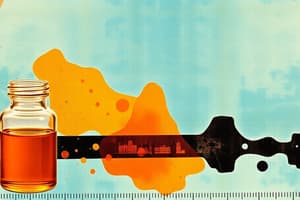Podcast
Questions and Answers
Which statement about colorimetric assays is correct?
Which statement about colorimetric assays is correct?
- Quantitative assays do not require spectrophotometers.
- Only binary assays provide qualitative results.
- Qualitative assays utilize color charts to estimate analyte concentration. (correct)
- All colorimetric assays rely exclusively on the Beer-Lambert Law.
What change occurs in Coomassie blue dye during the Bradford Assay?
What change occurs in Coomassie blue dye during the Bradford Assay?
- Its maximum absorbance wavelength shifts from 595 nm to 465 nm.
- It transitions from orange-red to blue upon binding to amino acids. (correct)
- It changes from blue to orange-red when bound to proteins.
- It becomes colorless after reacting with proteins.
What is indicated by a high R^2 value on a standard curve analysis?
What is indicated by a high R^2 value on a standard curve analysis?
- There is a poor fit between absorbance and concentration.
- The assay only operates in the qualitative range.
- There is a strong linear relationship between absorbance and concentration. (correct)
- The data is unreliable and should be discarded.
Which component is NOT part of the Beer-Lambert Law equation?
Which component is NOT part of the Beer-Lambert Law equation?
In a dilution problem, if you have 100 µL of a 1 mg/mL protein sample and dilute it to a total of 500 µL, what will the final concentration be?
In a dilution problem, if you have 100 µL of a 1 mg/mL protein sample and dilute it to a total of 500 µL, what will the final concentration be?
Which of the following is a common error that can affect the accuracy of measurements in colorimetric assays?
Which of the following is a common error that can affect the accuracy of measurements in colorimetric assays?
How can you ensure that your standard curve is valid?
How can you ensure that your standard curve is valid?
What is the consequence of not achieving equilibrium in early-stage reactions within a colorimetric assay?
What is the consequence of not achieving equilibrium in early-stage reactions within a colorimetric assay?
Which equation is used to calculate the unknown protein concentration in the Bradford Assay?
Which equation is used to calculate the unknown protein concentration in the Bradford Assay?
Which of the following describes qualitative colorimetric assays?
Which of the following describes qualitative colorimetric assays?
Flashcards
Colorimetric Assay
Colorimetric Assay
A method to analyze a sample by measuring the change in color of a reagent in the presence of an analyte (substance to be detected).
Binary Assay
Binary Assay
A colorimetric assay that gives a positive or negative result, indicating the presence or absence of an analyte.
Quantitative Colorimetric Assay
Quantitative Colorimetric Assay
A colorimetric assay used to measure the exact amount of an analyte using a spectrophotometer and a standard curve.
Bradford Assay
Bradford Assay
Signup and view all the flashcards
Standard Curve
Standard Curve
Signup and view all the flashcards
Beer-Lambert Law
Beer-Lambert Law
Signup and view all the flashcards
Linear Range
Linear Range
Signup and view all the flashcards
Dilution Formula
Dilution Formula
Signup and view all the flashcards
R-squared
R-squared
Signup and view all the flashcards
Errors in Measurement
Errors in Measurement
Signup and view all the flashcards
Study Notes
Colorimetric Assays
- Assays use reagents that change color in the presence of an analyte (chemicals like enzymes, proteins, antibodies or hormones)
- Binary Assays: Provide positive/negative results (e.g., pregnancy tests)
- Qualitative Assays: Estimate analyte concentration using color charts (like pH litmus paper or aquarium test strips)
- Quantitative Assays: Measure photon absorption using a spectrophotometer at specific wavelengths.
- Quantitative Assays correlate absorbance with analyte concentration using a standard curve.
The Bradford Assay
- A colorimetric assay for protein detection.
- Coomassie blue dye changes from orange-red to blue when bound to amino acids.
- Maximum absorbance shifts from 465 nm to 595 nm.
- The assay completes in less than 5 minutes.
- Quantitative Analysis: Uses a linear standard curve to define protein concentration.
- Protein concentration (µg/mL) calculation: 100.46 * absorbance at 565 nm
Beer-Lambert Law
- Describes the relationship between absorbance (A), molar absorptivity (ε), path length (b), and molar concentration (c): A = εbc
Standard Curve Analysis
- Essential for identifying analyte concentration relationships.
- Reliable within the linear range (a high R² value, ideally ≥ 0.95).
- Plot absorbance versus concentration for known samples.
- Exclude outliers outside the linear range.
- The equation of the linear trendline shows the relationship between absorbance and concentration.
- High R²: Indicates a good fit and accurate relationship.
- Low R²: Signals significant deviations, suggesting unreliable data.
Dilution of Solutions
- Formula: M1V1 = M2V2
- M1 = initial concentration, V1 = initial volume
- M2 = final concentration, V2 = final total volume
- Example: Diluting a 1 mg/mL protein sample in a 1:5 ratio (100 µL + 400 µL PBS) results in a 0.2 mg/mL final concentration.
Molar Concentration
- Molar concentration (M) = (Mass concentration, g/L) / Molecular weight (g/mol)
Errors in Measurements
- Sources: Inconsistent sample preparation, colorimeter calibration inaccuracies, reactions not reaching equilibrium, contamination or human error.
- Improvement Tips: Instrument calibration before use, consistent sample handling, allowing reactions to reach equilibrium.
Studying That Suits You
Use AI to generate personalized quizzes and flashcards to suit your learning preferences.





